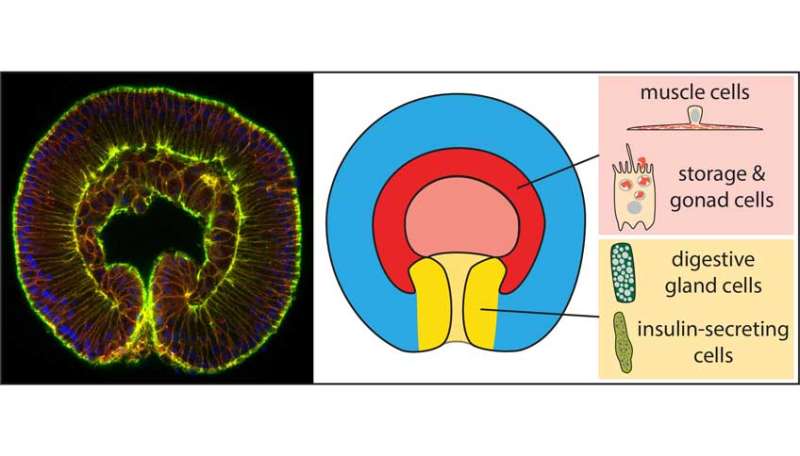The evolutionary origin of the gut

How did the gut, the skin and musculature evolve? This question concerns scientists for more than a century. Through the investigation of the embryonic development of sea anemones, a very old animal lineage, researchers from the University of Vienna have now come to conclusions which challenge the 150 year-old hypothesis of the homology (common evolutionary origin) of the germ layers that form all later organs and tissues.
According to a 150 year-old hypothesis, all tissues and organs in our body derive from one of three germ layers that are established during early embryogenesis. This "germ layer hypothesis" states that skin and nervous system derive from the outer ectoderm layer, the gut and some inner organs, like the pancreas, derive from the inner endoderm layer, while muscles and gonads stem from the middle layer, the mesoderm. Early on, researchers noted a fundamental difference in the number of germ layers in different animal groups.
While most animals, like humans, insects and worms, develop from three germ layers, the cnidarians (corals, sea anemones or jellyfish) lack the intermediate layer and present only two cell layers during development and throughout life. The emergence of mesoderm as the third intermediate germ layer is considered a key event during the evolution of complex animals. So far, however, it was controversial how mesoderm has evolved, and how the two cnidarian germ layers relate to the three layers in most other animals. A new publication from the laboratory of Ulrich Technau at the Department for Molecular Evolution and Development of the University of Vienna presents a fundamentally new view of the evolution of germ layers.
The inner-most, gut-forming endoderm has always been considered as evolutionary related between cnidarians and other animals. In their study, Technau and colleagues have now tested this hypothesis by tracing the embryonic origin of digestive enzyme-producing cells as well as their developmental regulator genes typical of the gut and pancreas in a sea anemone. The authors show that in sea anemones, against all previous beliefs, digestive enzyme- and insulin-producing gland cells do not develop from endoderm but from the ectodermal part of the mouth, the pharynx. "I was puzzled when I first saw that all endoderm derivatives of sea anemones are totally devoid of digestive gland cells. That was not what is taught in biology textbooks" explains Patrick Steinmetz, who contributed most of the experiments and is now a group leader at the University of Bergen in Norway.
"The results completely change the way we think of the origin of germ layers. It means that 'endoderm' in sea anemones and vertebrates, although they are called the same, are actually not evolutionary related" adds Ulrich Technau. If the mouth ectoderm of the sea anemone and not the endoderm corresponds to the vertebrate gut and pancreas, then what is the vertebrate correlate of the sea anemone endoderm? When Steinmetz and Technau delved deeper into this question, they found strong similarities between the cnidarian endoderm and the intermediate mesoderm layer: both share a large number of regulatory genes, and both give rise to similar cell types such as muscle or gonad cells. The sea anemone thus shows a clear correlate of mesoderm, but not in an intermediate position as found in three-layered animals. Positioning, and not novel emergence, of tissue in-between the gut and skin was thus the key event that led to the evolution of three-layered animals.
"An overwhelming majority of animals nowadays develop three germ layers, and we have taken a big step towards the understanding of one of the most crucial events underlying this evolutionary success story" concludes Steinmetz.
More information: Patrick R. H. Steinmetz et al, Gut-like ectodermal tissue in a sea anemone challenges germ layer homology, Nature Ecology & Evolution (2017). DOI: 10.1038/s41559-017-0285-5
Journal information: Nature Ecology & Evolution
Provided by University of Vienna



















